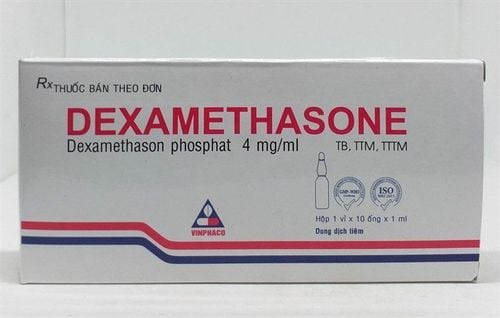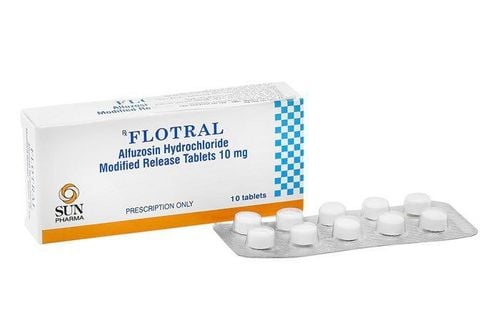This is an automatically translated article.
Meperidine is an opioid analgesic used to relieve moderate to severe pain. Meperidine abuse can cause drug dependence and addiction. Therefore, the indication and use must be as cautious as for the use of morphine.
1. What is Meperidine?
Meperidine contains the active ingredient meperidine, also known as pethidine. It is a central analgesic with morphine-like properties, but has a faster and shorter duration of action than morphine. The drug is available in different strengths such as meperidine 50mg or meperidine 100mg. The drug's mechanism of action is to bind to opioid receptors in the central nervous system, thereby helping to reduce pain. Meperidine is used in the following cases:Pain relief in moderate to severe pain. Pain relief in obstetrics and gynecology. Auxiliary drugs for anesthesia. Used to relieve pain after surgery.
2. What are the contraindications of meperidine?
Hypersensitivity (eg, anaphylaxis) to meperidine or any of the excipients. Use with or within 14 days of an MAO inhibitor Significant respiratory depression, acute or severe asthma in unsupervised conditions or without resuscitation equipment Gastrointestinal obstruction, including paralysis bowel or any disease affecting bowel transit Possibility of abdominal surgery (eg, acute appendicitis or pancreatitis) Mild pain that can be controlled with analgesics Other Alcoholics Patients with delirium and seizure disorders Severe CNS depression, increased intracranial pressure and head trauma
3. Dosage of Meperidine
Adults Pain relief: Take 50 - 150 mg / time, every 4 hours if necessary. It can be used intramuscularly or subcutaneously with a dose of 25-100mg/time and slow intravenous injection with a dose of 25-50mg/time and repeated injection after 4 hours.
Postoperative pain relief: subcutaneously or intramuscularly every 2-3 hours if necessary.
Obstetric analgesia: 50 mg intramuscularly or subcutaneously as soon as contractions appear at regular intervals.
Preparation for anesthesia: 25-100 mg intramuscularly about 1 hour before surgery, or can be injected subcutaneously with the same dose.
Children Pain relief: orally or intramuscularly at a dose of 0.5 - 2 mg/kg, repeat after 4 hours if necessary.
Pain after surgery: IM every 2-3 hours if needed.
Preparation for anesthesia: Intramuscular dose of 0.5 - 2 mg/kg about 1 hour before surgery.
In patients with hepatic impairment, the drug should be used with caution and the dose reduced if necessary.
What are the side effects of Meperidine?
Cardiovascular: Bradycardia, cardiac arrest, circulatory collapse, flushing, hypotension, palpitations, shock, syncope, tachycardia Central nervous system: Agitation, confusion, delirium, loss disorientation, dizziness, drug dependence, hallucinations, headache, increased intracranial pressure, involuntary muscle movements (including myoclonus, myoclonus), mood swings (including mania) chalk, difficulty breathing) , sedation, convulsions, serotonin syndrome Dermatology: Allergic, pruritus, skin rash, urticaria Gastrointestinal: biliary colic, constipation, nausea, vomiting Genitourinary: Urinary retention Hypersensitivity : Anaphylaxis, histamine release, hypersensitivity reactions Local: Injection site reactions (pain, swelling) Neuromusculoskeletal: Tremor, asthenia Ophthalmology: Visual disturbances Respiratory: Shortness of breath, respiratory depression
5. What are the precautions when taking Meperidine?
Effects on the central nervous system: The drug can cause neurasthenia, impairing physical and mental abilities. Therefore, patients taking the drug should be warned when performing tasks that require mental alertness (eg, operating machinery or driving a vehicle).
Central nervous system events: Normeperidine (an active metabolite) can build up and cause anxiety, tremors or convulsions. Risk of events is increased with CNS dysfunction, impaired renal function, or prolonged use (more than 48 hours)
Hypotension: May cause severe hypotension (including hypotension). orthostatic blood pressure and syncope). Use with caution in patients with hypovolemia, cardiovascular disease or drugs that may enhance the hypotensive effect. Monitor for symptoms of hypotension after initiation of therapy. Avoid use in patients with circulatory shock.
Respiratory failure: Severe, life-threatening or fatal respiratory failure may occur. Closely monitor respiratory depression, especially when starting treatment or increasing the dose. Patients and family members should be educated on the signs of respiratory failure and the importance of emergency assistance in the event of a suspected overdose.
Serotonin syndrome : May occur with concomitant use of agents acting on the serotonergic system (eg, selective serotonin reuptake inhibitors, serotonin-norepinephrine reuptake inhibitors, triptans, antiretroviral agents). tricyclic depression), lithium, an MAO inhibitor. Monitor patients for serotonin syndrome such as altered mental status (eg, agitation, hallucinations, coma), tachycardia, unstable blood pressure, hyperthermia, neuromuscular changes.
Adrenal insufficiency: Use with caution and reduce the initial dose in patients with adrenal insufficiency, including Addison's disease. Prolonged use of opioid analgesics may cause secondary hypogonadism, leading to mood disturbances and osteoporosis
Biliary dysfunction: Use with caution in patients with biliary dysfunction , including acute pancreatitis
Pregnant women: Prolonged use of meperidine during pregnancy can lead to neonatal opioid withdrawal syndrome, which can be life-threatening if not recognized and treated. timely treatment. Although approved for use in obstetric analgesia, Meperidine is not recommended for analgesia during childbirth due to its metabolites having a prolonged duration of action in the mother and neonate. The drug is not recommended for the treatment of chronic cancer pain in pregnant women or those who may become pregnant.
Lactation: Mothers taking Meperidine while breastfeeding can lead to sedation in the infant and interfere with breastfeeding. Non-opioid analgesics are preferred for breastfeeding women who need pain management after childbirth or surgery beyond the postpartum period. Meperidine is not recommended if opioids are needed. When opioids are needed in a nursing woman, the lowest effective dose should be used for the shortest duration to limit adverse effects in the mother and nursing infant. According to the manufacturer, the decision to breastfeed during treatment should consider the risk of exposure to the infant, the benefits of breastfeeding, and the benefit of treatment to the mother.
Drug Interactions: Co-administration of meperidine with certain drugs can cause very dangerous interactions. For example, CYP3A4 inhibitors may increase meperidine plasma concentrations, which may increase or prolong side effects of the drug and cause respiratory depression which can be fatal. In addition, concomitant use of meperidine with MAO inhibitors (such as selegiline) can lead to coma, severe respiratory depression, cyanosis, and hypotension. Contraindicated use of meperidine with MAO inhibitors, MAO inhibitors must be discontinued at least 14 days before taking meperidine. Therefore, patients need to inform their doctor or pharmacist of all medications they are taking for appropriate advice.
In summary, Meperidine is a pain reliever with morphine-like properties. Improper use of Meperidine can lead to drug dependence and many dangerous side effects. Patients should consult a healthcare professional before use.
Please dial HOTLINE for more information or register for an appointment HERE. Download MyVinmec app to make appointments faster and to manage your bookings easily.













